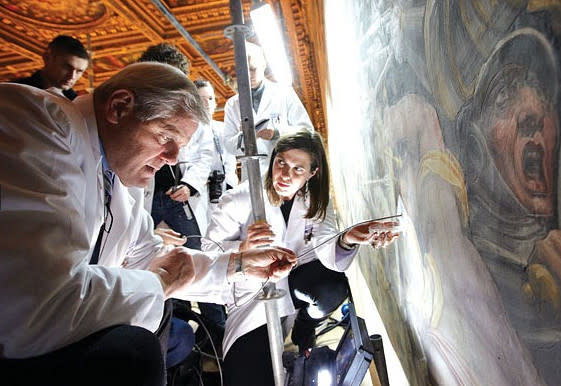 The Sideshow
The SideshowLost Leonardo da Vinci masterpiece thought to be found behind Florence fresco

In what some art experts say would be one of the biggest discoveries of the century, researchers in Italy think they may have discovered a long-lost painting by Leonardo da Vinci behind a 16th century fresco in Florence.
Scientists using endoscopic probes to look behind Giorgio Vasari's "The Battle of Marciano" in the Palazzo Vecchio say they've found traces of black paint that matches the pigment used in "St. John the Baptist" and in the "Mona Lisa," da Vinci's most-famous painting. The team—composed of researchers from National Geographic, University of California San Diego and the City of Florence—believes the Renaissance painter's unfinished "Battle of Anghiari," which da Vinci started in 1504, lies beneath Vasari's fresco.
"These data are very encouraging," Maurizio Seracini, the lead researcher, told reporters at a press conference. Seracini, though, cautioned that the discovery was "not conclusive" and the pigment would need further analysis.
"Although we are still in the preliminary stages of the research and there is still a lot of work to be done to solve this mystery, the evidence does suggest that we are searching in the right place," he said.
Other experts in the art world, however, are way more skeptical about the findings.
"What do they mean by saying the findings are compatible with Leonardo?" Tomaso Montanari, an art historian who launched a petition to stop Seracini's drilling of Vasari's 1563 mural, told the BBC. "Any painting from the Renaissance would be. Anything from that era could be painted on that wall."
According to the Telegraph, Seracini has spent more than 35 years searching for da Vinci's lost work.
What's lacking here "is a neutral team that has the scientific authority to evaluate this," Montanari added. "It is very complex."
More popular Yahoo! News stories:
• Apple WALT sold on eBay: Never-released gadget goes for $8,000
• Gov. Chris Christie to student: 'Damn man, I'm governor, could you shut up for a minute?'
• First amateur video of Challenger shuttle explosion revealed
